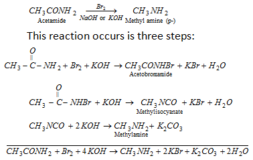urea-

source : ch.ic.ac.uk
Urea or NH2CONH2
Urea is di amide of carbonic acid therefore, it is also known as carbamide.

Methods of Preparation:
Laboratory Preparation-
a) Wohler Synthesis-
When potassium cyanate reacts with ammonium sulphate then Ammonium isocyanate is formed which on intermolecular rearrangement gives urea.
2KCNO + (NH4)2SO4 —->2NH4CNO +H2SO4

b) From phosgene or Ethyl Carbonate:
When carbonyl chloride or ethyl carbonate reacts with NH3 , urea is formed.


Manufacture-
a) From CaC2 or Partial hydrolysis of CaCN2–
When CaC2 reacts with N2 at 800 0 C , Calcium cyanamide is formed which on hydrolysis with dil. H2SO4 gives urea.

b) From CO2 & NH3–
When NH3 & CO2 are heated at 150-200 0 C & high pressure , ammonium Carbamate is formed, which on decomposition gives urea.

Physical Properties :
1. It is colourless, odourless, crystalline solid
2. Its melting point is 1320 C.
3. It is soluble in water due to formation of intermolecular hydrogen bonding with water
Chemical Properties :
1. Basic Nature –
It is mono acidic base but its aqueous solution is neutral. It forms salt with strong acid.
NH2CONH2 +HNO3 —–> NH2CONH2.HNO3
(urea nitrate)
2NH2CONH2 +H2C2O4 ——-> (NH2CONH2)2.H2C2O4
(urea oxalate)
2. Hydrolysis-

Urea on hydrolysis gives NH3 & CO2.
a) On hydrolysis with acid, NH4Cl & CO2 is formed

b) on hydrolysis with base, NH3 & Na2 CO3 is formed.
![]()
c) on hydrolysis in presence of urease enzyme, NH3 & CO2 is formed.

3. Effect of heat-
a) On heating at 1320 C- urea melts & on further slow heating, NH3 is evolved & a solid residue biuret is formed.

b) When urea is heated rapidly above 1700 C-
cyanic acid is formed which on polymerisation gives cyanuric acid.

3HNCO—->(HNCO)3

Cyanuric acid
4. Reaction with alkaline Sodium hypobromite-
we get N2 gas
NH2CONH2 +NaOBr + NaOH —->N2 +Na2CO3 +NaBr +H2O
5. Reaction with NaNO2 + HCl or HNO2– We get N2 & CO2 .
NH2CONH2 + 2 HNO2 —–>2N2 +3H2O + 2CO2
6. Reaction with Acetyl Chloride / Acetic Anhydride –
We get Acetyl urea , which is also known as ureides.
NH2CONH2 +CH3COCl —-> NH2CONHCOCH3 +HCl
NH2CONH2 +(CH3CO)2O —-> NH2CONHCOCH3 + CH3COOH
7. Reaction with Oxalic Acid-
In presence of phosphoryl Chloride, Oxalyl urea is formed.

8. Reaction with ethyl alcohol-
-As a result of reaction we get ethyl carbamate or urethane
NH2CONH2 +C2H5OH —–> NH2COOC2H5 +NH3
9. Reaction with hydrazene-
consequently, we get Semicarbazide .

10. Formation of cyclic ureides-
When it reacts with di ethyl malonate or di ethyl oxalate in presence of PCl3 , cyclic ureides are formed.

Uses-
-1 It is a good Nitrogenous fertilizer.
2. In the formation of Semi Carbazide.
3. In preparing urea-formaldehyde plastic.
Test-
1. Biuret Test-
When urea is heated gently then it gives solid residue biuret which gives violet colour with NaOH & CuSO4 solution.
2. It gives white precipitate of urea nitrate with Conc. HNO3
3. It on heating with NaOH gives NH3 gas.
4. When it reacts with oxalic acid , white precipitate of urea -oxalate is formed.
Read more articles at chemistryonline.guru








